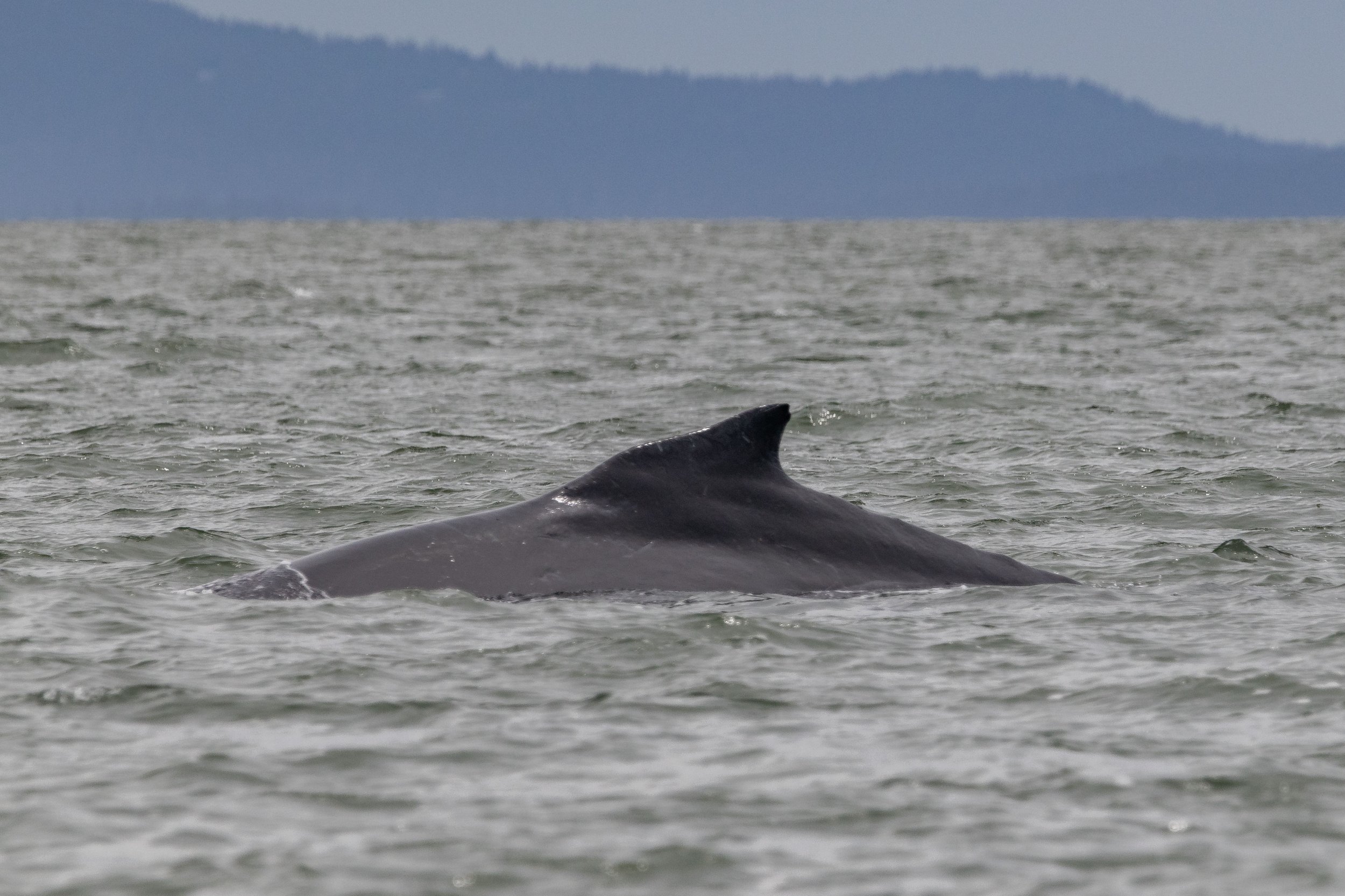May 28, 2024 - The Beginning of Humpback Land!
It was a very west-coast day as the clouds covered the sky and we headed out into the Salish Sea. With two of our boats out, we were able to spread out to cover more ground searching.
One boat headed into the Strait of Georgia where they quickly saw the tell-tale sign of whales in the distance, blows! Upon approach, it seemed like there were four whales in the area, and we could see that they were humpback whales thanks to their huge size and their tiny dorsal fins! Sometimes these dorsal fins can be used to ID the whales, but more often we use the underside of their tail flukes,
The tail of a humpback whale is almost 20 feet wide and can tell us a lot about the animal.
In BC there are three different classifications of whales:
X - has less than 20% white pigmentation on its underside
Y - has between 20%-80% white pigmentation on its underside
Z - has more than 80% white pigmentation on its underside.
The first whale that cooperated enough for an ID was Strike (BCX1675). She is a known female since she brought a calf back to our waters last year! She also spent a fair amount of time close to home for us two years ago, when she found Stuart Channel to be a fantastic place to hang out for a few months.
Today Strike was travelling with three other whales: Kelpie (BCY1276), Coyote (BCX0837calf2021), and another who wasn’t being cooperative with their fluke. Hopefully, we will be able to figure it up and update it here!
While spending time with Strike and friends, we saw even more blows off in the distance! We decided to leave these four to their feeding and see who else was close by. Although our boats were going about the same way, they ended up finding two different groups of whales.
The semi-covered boat had an interesting encounter with their group of three who were: Viking (BCY1063), Bagheera (BCY0523calf2021), and one who we think is a young whale, maybe even a calf from last year who has returned to the Salish Sea. For this young whale we have a partial fluke, so we are hopeful we will be able to figure it out soon. The star of the show here though, was Bagheera, as they did something biologists always get excited about: pooping! Bagheera came up beside the boat and let out a pink cloud of poop. Sometimes it can be concerning if you don’t know what’s happening, due to the colour. It is often mistaken for blood, but it’s coloured that way thanks to the humpback’s food source: Krill! The exoskeletons of the krill don’t get fully broken down in the whale’s digestive system, leaving their excrement this lovely shade of pink. The poop accompanied by a swish of the tail made for a very unique encounter.
While this was happening the open boat had found its own whales, with lots in the area, we were able to identify the following whales from the group: Moraine (BCX1383calf2021), BCY0649calf2022, and Split Fluke (BCX1058). We estimated these to be up to ten whales in the area, but only time will tell if we are able to ID the rest of them!
With their time with the whales up, the boats then headed off to find other wildlife including Harbour Seals, Sea Lions, Bald Eagles, and more! You can see all the great photos from the day taken by Marine Naturalists Cheyenne Brewster and Lucy Willis below.
Strike showing off the bottom side of her tail flukes, Photo by Cheyenne Brewster.
Viking’s unique dorsal fin. Photo by Cheyenne Brewster.
Bagheera surfacing in the Strait. Photo by Cheyenne Brewster.
Bagheera’s dorsal fin. Photo by Cheyenne Brewster.
Bagheera lifting their fluke. Photo by Cheyenne Brewster.
And a tail flick from Bagheera. Photo by Cheyenne Brewster.
Bagheera’s dorsal fin again. Photo by Cheyenne Brewster.
A big tail swish from Bagheera. Photo by Cheyenne Brewster.
See the poop in the water. Photo by Cheyenne Brewster.
You don’t want to get splashed by this! Photo by Cheyenne Brewster.
Poop in the water. Thanks Bagheera! Photo by Cheyenne Brewster.
So much poop! Photo by Cheyenne Brewster.
Bagheera’s dorsal fin. Photo by Cheyenne Brewster.
The underside of Bagheera’s tail flukes. Photo by Cheyenne Brewster.
The two line markings on the left fluke are one of the ways we ID Bagheera. Photo by Cheyenne Brewster.
Viking’s dorsal fin. Photo by Cheyenne Brewster.
The top side of Bagheera’s top fluke. Photo by Cheyenne Brewster.
Coyote’s unique dorsal fin. Photo by Lucy Willis
Kelpie can be IDed with her dorsal surface, particularly thanks to the scarring all over her body from a skin condition. Photo by Lucy Willis
Strike about to lift her tail for a dive. Photo by Lucy Willis
One of our Mystery Whales! Photo by Lucy Willis
Split Fluke’s dorsal fin has a scar that we can use to ID her. Photo by Lucy Willis.
A side photo of Split Fluke diving. You can see the chunk missing from the left side of her tail. Photo by Lucy Willis.
Another mystery whale! Photo by Lucy Willis.
Mystery dorsal fin #3. Photo by Lucy Willis.
Steller Sea Lions on Stinky Rock. Photo by Cheyenne Brewster.
A very angry Sea Lion. Photo by Cheyenne Brewster.
Harbour Seals hauled out on the rocks. Photo by Cheyenne Brewster.
A curious Bald Eagle. Photo by Lucy Willis.
Harbour Seals on the Fucus. Photo by Lucy Willis.
So cute! Photo by Lucy Willis.
A juvenile Bald Eagle in flight. Photo by Lucy Willis.
A juvenile bald eagle next to an adult. Photo by Lucy Willis.
Cormorants on the Bluffs. Photo by Lucy Willis.
A cormorant in flight! Photo by Lucy Willis.



































